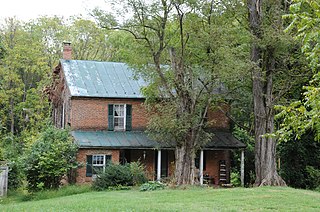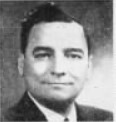
Alger Hiss was an American government official accused in 1948 of having spied for the Soviet Union in the 1930s. The statute of limitations had expired for espionage, but he was convicted of perjury in connection with this charge in 1950. Before the trial Hiss was involved in the establishment of the United Nations, both as a US State Department official and as a UN official. In later life, he worked as a lecturer and author.

Whittaker Chambers was an American writer and intelligence agent. After early years as a Communist Party member (1925) and Soviet spy (1932–1938), he defected from the Soviet underground (1938), worked for Time magazine (1939–1948), and then testified about the Ware Group in what became the Hiss case for perjury (1949–1950), often referred to as the trial of the century, all described in his 1952 memoir Witness. Afterwards, he worked as a senior editor at National Review (1957–1959). US President Ronald Reagan awarded him the Presidential Medal of Freedom posthumously in 1984.
Julian Wadleigh (1904–1994) was an American economist and a Department of State official in the 1930s and 1940s. He was a key witness in the Alger Hiss trials.
Marion Bachrach was a member of the Ware group, a group of government employees in the New Deal administration of President Franklin D. Roosevelt who were also members of the secret apparatus of the Communist Party of the United States (CPUSA) in the 1930s. She was the sister of John Abt.
Headed by Victor Perlo, the Perlo group is the name given to a group of Americans who provided information which was given to Soviet intelligence agencies; it was active during the World War II period, until the entire group was exposed to the FBI by the defection of Elizabeth Bentley.

The Whittaker Chambers Farm, also known as the Pipe Creek Farm, is a historic cluster of farm properties near Westminster in rural Carroll County, Maryland. The farm's historic significance comes from its ownership by Whittaker Chambers (1901-1961), a pivotal figure in American Cold War politics. In December 1948, Chambers hid the "Pumpkin Papers" (microfilm) while awaiting a subpoena from the House Un-American Activities Committee to relinquish any intelligence stolen from the US Government by members of the Soviet spy rings within the federal government. Chambers also wrote his best-selling 1952 memoir Witness there. The property was designated a National Historic Landmark in 1988, in a somewhat controversial decision. The property remains in the Chambers family and is not accessible to the public.

A dumbwaiter is a small freight elevator or lift intended to carry food. Dumbwaiters found within modern structures, including both commercial, public and private buildings, are often connected between multiple floors. When installed in restaurants, schools, hospitals, retirement homes or private homes, they generally terminate in a kitchen.

Perjury: The Hiss–Chambers Case is a 1978 book by Allen Weinstein on the Alger Hiss perjury case. The book, in which Weinstein argues that Alger Hiss was guilty, has been cited by many historians as the "most important" and the "most thorough and convincing" book on the Hiss–Chambers case. Weinstein drew upon 30,000 pages of FBI documents released through the Freedom of Information Act, the files of the Hiss defense attorneys, over 80 interviews with involved parties and six interviews with Hiss himself. In 1997, Weinstein published an updated and revised edition of Perjury, which incorporated recent evidence from Venona project decrypted cables, released documents from Soviet intelligence archives and information from former Soviet intelligence operatives.
Carl Binger (1889–1976), AKA Carl A. L. Binger, was a 20th-century American psychiatrist. He wrote books and articles on a wide range of topics, including medicine and psychiatry, and testified in the trial of Alger Hiss.

The House Committee on Un-American Activities (HCUA), popularly the House Un-American Activities Committee (HUAC), was an investigative committee of the United States House of Representatives, created in 1938 to investigate alleged disloyalty and subversive activities on the part of private citizens, public employees, and those organizations suspected of having communist ties. It became a standing (permanent) committee in 1946, and from 1969 onwards it was known as the House Committee on Internal Security. When the House abolished the committee in 1975, its functions were transferred to the House Judiciary Committee.
Maxim Lieber was a prominent American literary agent in New York City during the 1930s and 1940s. The Soviet spy Whittaker Chambers named him as an accomplice in 1949, and Lieber fled first to Mexico and then Poland not long after Alger Hiss's conviction in 1950.
Bertrand Albert Andrews Jr. was a Washington-based reporter for the New York Herald Tribune who won the Pulitzer Prize in 1948 for his article "A State Department Security Case."

Alexander Morton Campbell (1907–1968) was an Indiana lawyer who served in the United States Department of Justice as Assistant U.S. Attorney General for the Criminal Division, formally from August 1948 through December 20, 1949, under Tom C. Clark as U.S. Attorney General (1945–49).
Nathan Levine was an American labor lawyer and real estate attorney in Brooklyn, New York, who, as attorney for his uncle, Whittaker Chambers, testified regarding his uncle's "life preserver." This packet included papers handwritten by Alger Hiss and Harry Dexter White, as well as typewritten by the Hiss Family's Woodstock typewriter. It also included microfilm, paraded to the public by U.S. Representative Richard M. Nixon and HUAC investigator Robert E. Stripling, dubbed the "Pumpkin Papers" by the press, which helped lead to the U.S. Department of Justice to indict Hiss for perjury.

John Lowenthal (1925–2003) was a 20th-century American lawyer, civil servant, law professor, and documentary filmmaker, who defended the name and reputation of family friend Alger Hiss almost all his life.
Harold Rosenwald was an American lawyer, best known for working on the defense team of Alger Hiss during 1949 and in the prosecution of Louisiana governor Huey Long.
Robert E. Stripling was a 20th-century civil servant, best known as chief investigator of the House Dies Committee and its successor the House Un-American Activities Committee (HUAC), particularly for collaboration with junior congressman Richard Nixon and for testimony gleaned from witness Elizabeth Bentley and Whittaker Chambers, the latter of whose allegations led indirectly to indictment and conviction of State Department official Alger Hiss in January 1950.
Louis James Russell was an American special agent and investigator for the Federal Bureau of Investigation, the House Un-American Activities Committee, and a private detective agency involved in the Watergate scandal.

Witness, first published in May 1952, is a best-selling book of memoirs by American writer Whittaker Chambers (1901–1961), which recounts his life as a dedicated Marxist-communist ideologist in the 1920s, his work in the Soviet underground during the 1930s, and his 1948 testimony before the US Congress, which led to a criminal indictment against Alger Hiss and two trials in 1949.











